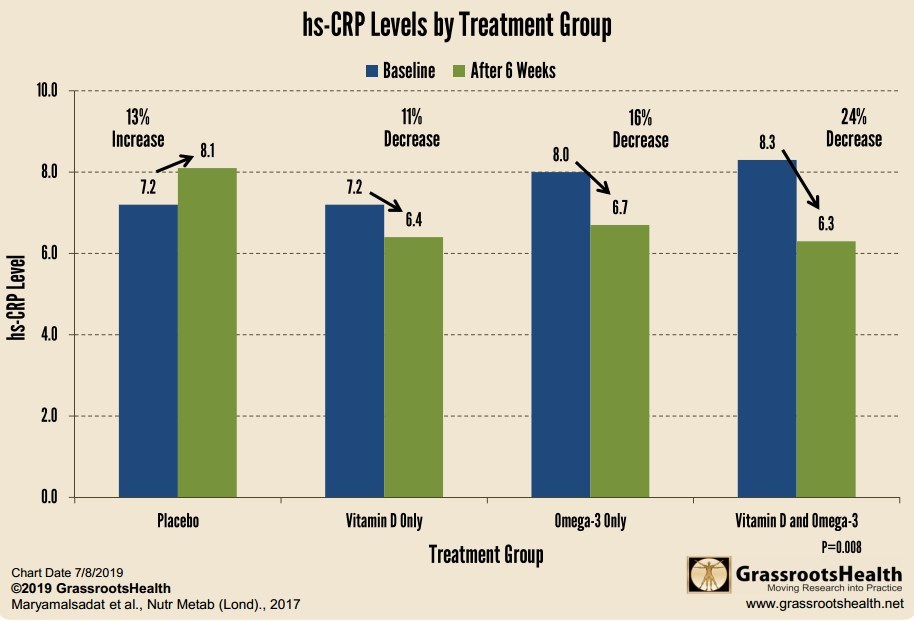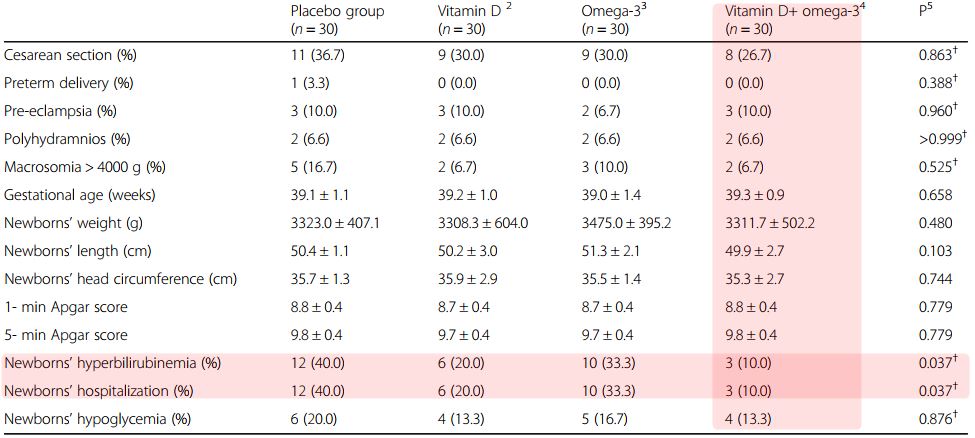Gestational diabetes treated by Vitamin D plus Omega-3 – RCT
The effects of vitamin D and omega-3 fatty acid co-supplementation on glycemic control and lipid concentrations in patients with gestational diabetes - Feb 2017
Journal of Clinical Lipidology, online 2 Feb 2017, http://dx.doi.org/10.1016/j.jacl.2017.01.011
Mehri Jamilian, MD1, Mansooreh Samimi, MD2, Faraneh Afshar Ebrahimi, MD2, Teibeh Hashemi, MD3, Mohsen Taghizadeh, PhD3, Maryamalsadat Razavi, MD4, , , Marzieh Sanami, BSc3, Zatollah Asemi, PhD3, ,
2000mg Omega3
600mg EPA
480mg DHA | 50,000 IU Vit D * | 50,000 IU Vit D *
2000 mg Omega3 | No Vitamin D
No Omega-3 | | fasting plasma glucose | -7 | -7 | -4 | * 1 | | serum insulin levels | -1 | -1 | 0 | * 3 | | HOMA-IR | -0.7 | -0. | -0.2 | * 0.6 | | serum triglycerides | -8 | * 8 | * 4 | * 20 | | VLDL-cholesterol | -2 | * 2 | 0` | * 4 | * every 2 weeks, otherwise daily
Objective
This study was performed to evaluate the effects of vitamin D and omega-3 fatty acids co- supplementation on glucose metabolism and lipid concentrations in gestational diabetes (GDM) patients.
Methods
This randomized double-blind placebo-controlled clinical trial was done among 140 GDM patients. Participants were randomly divided into four groups to receive:
1) 1000 mg omega-3 fatty acids containing 360 mg eicosapentaenoic acid (EPA) and 240 mg docosahexaenoic acid (DHA) twice a day+ vitamin D placebo (n=35);
2) 50,000 IU vitamin D every 2 weeks+ omega-3 fatty acids placebo (n=35);
3) 50,000 IU vitamin D every 2 weeks+1000 mg omega-3 fatty acids twice a day (n=35) and
4) vitamin D placebo+omega-3 fatty acids placebo (n=35) for 6 weeks.
Results
After 6 weeks of intervention , patients who received combined vitamin D and omega-3 fatty acids supplements compared with vitamin D, omega-3 fatty acids and placebo had significantly decreased
fasting plasma glucose (FPG) (-7.3±7.8, -6.9±6.6, -4.0±2.5 and +1.0±11.4 mg/dL, respectively, P<0.001),
serum insulin levels (-1.9±1.9, -1.3±6.3, -0.4±6.3 and +2.6±6.5 μIU/mL, respectively, P=0.005),
homeostatic model of assessment for insulin resistance (HOMA-IR) (-0.7±0.6, -0.5±1.4, -0.2±1.5 and +0.6±1.5, respectively, P<0.001)
increased quantitative insulin sensitivity check index (QUICKI) (+0.01±0.01, +0.008±0.02, +0.002±0.02 and -0.005±0.02, respectively, P=0.001). In addition, changes in
serum triglycerides (-8.2±41.0, +7.6±31.5, +3.6±29.9 and +20.1±29.6 mg/dL, respectively, P=0.006) and
VLDL-cholesterol (-1.6±8.2, +1.5±6.3, +0.8±6.0 and +4.0±5.9 mg/dL, respectively, P=0.006) in the vitamin D plus omega-3 fatty acids group were significantly different from the changes in these indicators in the vitamin D, omega-3 fatty acids and placebo groups.
Conclusion
Overall, vitamin D and omega-3 fatty acids co-supplementation for 6 weeks among GDM patients had beneficial effects on FPG, serum insulin levels, HOMA-IR, QUICKI, serum triglycerides and VLDL-cholesterol levels.
Publisher wants $36 for the PDF
The effects of vitamin D and omega-3 fatty acids co-supplementation on biomarkers of inflammation, oxidative stress and pregnancy outcomes in patients with gestational diabetes - Dec 2017
It appears the same RCT was re-published with free PDF later in 2017
Nutrition & Metabolism201714:80, https://doi.org/10.1186/s12986-017-0236-9. Dec 2017
Maryamalsadat Razavi, Mehri Jamilian, Mansooreh Samimi, Faraneh Afshar Ebrahimi, Mohsen Taghizadeh, Reza Bekhradi, Elahe Seyed Hosseini, Hamed Haddad Kashani, Maryam Karamali and Zatollah Asemi
📄 Download the PDF from VitaminDWiki
Grassroots Health Plot of Data


Nice outcome trends for this short small study
Anticipate that a long study with more mothers would get many statistically significant results

Background
This study was carried out to determine the effects of vitamin D and omega-3 fatty acids co- supplementation on biomarkers of inflammation, oxidative stress and pregnancy outcomes in gestational diabetes (GDM) patients.
METHODS:
This randomized, double-blind, placebo-controlled trial was conducted among 120 GDM women.
Participants were randomly divided into four groups to receive:
1) 1000 mg omega-3 fatty acids containing 180 mg eicosapentaenoic acid (EPA) and 120 mg docosahexaenoic acid (DHA) twice a day + vitamin D placebo (n = 30);
2) 50,000 IU vitamin D every 2 weeks + omega-3 fatty acids placebo (n = 30);
3) 50,000 IU vitamin D every 2 weeks + 1000 mg omega-3 fatty acids twice a day (n = 30) and
4) vitamin D placebo + omega-3 fatty acids placebo (n = 30) for 6 weeks.
Results
Subjects who received vitamin D plus omega-3 fatty acids supplements compared with vitamin D, omega-3 fatty acids and placebo had significantly decreased high-sensitivity C-reactive protein (−2.0 ± 3.3 vs. -0.8 ± 4.4, −1.3 ± 2.4 and +0.9 ± 2.7 mg/L, respectively, P = 0.008), malondialdehyde (−0.5 ± 0.5 vs. −0.2 ± 0.5, −0.3 ± 0.9 and +0.5 ± 1.4 μmol/L, respectively, P < 0.001), and increased total antioxidant capacity (+92.1 ± 70.1 vs. +55.1 ± 123.6, +88.4 ± 95.2 and +1.0 ± 90.8 mmol/L, respectively, P = 0.001) and glutathione (+95.7 ± 86.7 vs. +23.0 ± 62.3, +30.0 ± 66.5 and −7.8 ± 126.5 μmol/L, respectively, P = 0.001). In addition, vitamin D and omega-3 fatty acids co-supplementation, compared with vitamin D, omega-3 fatty acids and placebo, resulted in lower incidences of newborns’ hyperbilirubinemiain (P = 0.037) and newborns’ hospitalization (P = 0.037).
Conclusion
Overall, vitamin D and omega-3 fatty acids co-supplementation for 6 weeks among GDM women had beneficial effects on some biomarkers of inflammation, oxidative stress and pregnancy outcomes.
See also VitaminDWiki
Overview: Omega-3 many benefits include helping vitamin D
Overview Loading of vitamin D contains the following
{include}
VitaminDWiki - studies listed in BOTH of the categories Omega-3 and Pregnancy
{category}
VitaminDWiki with GESTATIONAL DIABETES in title (36 as of July 2022)
This list is automatically updated
{LIST()}
